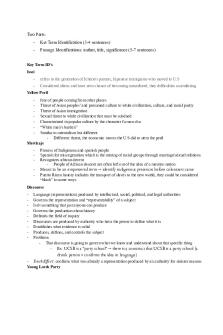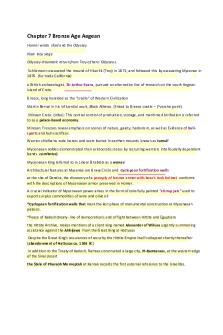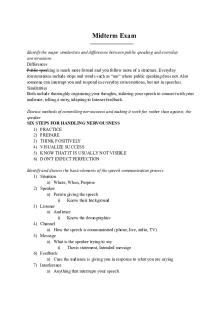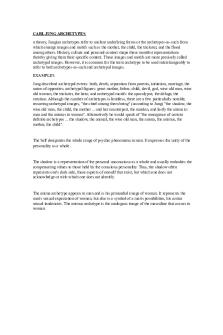Marketing Midterm 1 - Professor: Minah Jung PDF

| Title | Marketing Midterm 1 - Professor: Minah Jung |
|---|---|
| Course | Intro to Marketing |
| Institution | New York University |
| Pages | 6 |
| File Size | 340 KB |
| File Type | |
| Total Downloads | 15 |
| Total Views | 135 |
Summary
Professor: Minah Jung...
Description
1. Evolution of Marketing Concept a. Production: Goods were scarce, they sold themselves i. Focus: to increase production efficiency and reduce costs ii. Ford Model T: by 1914, 9/10 of every cars in the world were Fords b. Product: Increased competition. Managers believe goods sold themselves as long as they have better quality i. Focus: design a technically superior products ii. Coca-cola, mouse-trap c. Selling: Consumers won’t buy enough of the products if left alone i. Focus: to sell more of what we make ii. Insurance and phones d. Cutomer: find the right products for customers i. Focus: to meet customer needs better than competitors e. Holistic Marketing: Everything matters in marketing i. Focus: a broad, integrated perspective is necessary 2. What’s Marketing a. the activity, set of institutions, and processes for creating, communicating, delivering, and exchanging offerings that have value for customers, clients, partners, and society at large. b. 2018: Marketing is the process of creating value by identifying and profitably satisfying target customers’ needs in search for their loyalty 3. Selling Concept vs. Marketing concept a. Selling concept i. Focus on existing products → selling and promotion → profits through volume
4. 5.
6. 7.
8.
9.
b. Marketing Concept i. Focus on customer needs → increase customer value → profits through satisfaction What does good marketing produce? a. Good brand & satisfied customers Brand: Accumulation of a customer’s emotions, experiences, beliefs about particular goods & services. a. “The most sustainable competitive advantage known to a business” b. Firms brand to move beyond commodities and to reduce the primacy of price in the consumer decision process Market Capitalization: The value of a company that’s traded on the stock market, calculated by multiplying the total number of shares by the present share price. Customer Value a. Value is created by meeting customer needs: A firm needs to define itself not by the product it sells, but by the customer value provided. Value is the worth or utility of the product in the customers’ eyes and is driven by how much the offering statisfies the customers’ needs. Consumers’ Needs a. Not all needs are readily expressed b. There are latent needs c. One product may satisfy different needs for different people Marketing Framework ASI a. Learning: 3 C’s: Customer, Company, Competitor. & Customer Value, Marketing Metrics b. Doing: Segmentation, Targeting, Positioning. → Marketing Actions (4 p’s)
10. 3 Central marketing planning questions a. What are the needs, behaviors and beliefs that determine choice given the competitive environment? b. What is the value proposition or positioning of our product and how does it relate to the brand? c. How should we optimize marketing actions? 11. 3 central customer insights questions a. Who makes the relevant purchasing decision? i.
b. Why do customer choose our product over the competing alternatives in the consideration set?
i. ii.
Competitive Advantage Analytics Tool Perceptual Map: A way of visualizing the competitive positions of different brands. Two dimensions are identified that are important differentiators from the customer perspective. Then each individual competitor is plotted on these dimensions c. How do customers learn, evaluate and make the purchase (and repurchase) decision? i.
d. Necessary steps that must occur for re-purchase i. Aware of need → aware of brand → preference for the brand → available → purchase → repurchase 12. Weapons of Influence
a. 13. Reciprocation a. Reciprocity Rule: repay, in kind, what another person provided you b. The repaid favor doesn’t have to equal the initial favor in terms of value c. Why reciprocation work? → people are social beings and we have a need for belonging. The indebtness triggers a feeling of being uncomfortable. d. Rejection-then-retreat technique: you start by making a request (or offer) that you know will likely never be accepted. Once rejected, you make a more reasonable request or offer, and your concession sparks a return concession, either in the form of approval or perhaps a price reduction 14. Comitment & Consistency a. The commitment-consistency principle i. Elicit small commitment→ want people to think that they are doing something for
intrinsic drives. ii. Self-image changes iii. Person will naturally comply with subsequent requests to be consistent with her view of herself b. Commitment can be enhanced by i. Write statements down ii. Make statement public iii. No external reward for committing behavior c. Foot-in-the-door i. a small request is initially made in order to get a person to later agree to a bigger request ii. Lowball offer to get customer committed to purchase → subsequently ask higher iii.
price Ex. Car dealers & subscription to magazines
15. Loyalty a. Behavioral Loyalty vs. Attitudinal Loyalty i. Behavioral→ I intend to buy X regularly ii.
Attitudinal→ I would be willing to postepone my purchase if X was temporarily closed
1. I would stick w/ X even if it let me down once or twice b. Fan loyalty i. Extreme loyalty that people will pay a premium to exhibit c. Customer Relationship Management i. The process of creating, maintaining, and enhancing strong, value-laden relationships w/ customers and other stakeholders d. Basic CRM Strategy i. Customers yield streams of revenue over time 1. Length of revenue stream 2. Magnitude of revenue stream 3. Network effects ii. Acquisition activities 1. Advertising 2. Introductory prices iii. Retention Activities 1. Pricing 2. Service 3. Product development 16. RFM Analysis a. Premise of RFM: Past behavior is predictive of future behavior b. RFM variables= CRM segmentation variables i. Frequency, recency, monetary 17. Calculating CLV
a. b. AcqCost= Cost of spending a catalog/response rate 18. Implications of CLV Analysis a. CLV as a segmentation variable i. Rewarding customers ii. Firing customers b. CLV as an objective function i. The goal is to maximize expected CLV ii. Increasing CLV (cross-and-up-selling) c. Direct and indirect value i. Customer value= dierct value from stream of purchases + indirect value from the customers world of mouth. ii. Communication value 1. Reach: how many people will be informed 2. Influence: likelihood of changing others’ beliefs 3. Impact: likelihood of change in others’ behavior 19. STP of Marketing a. Segmentation: group consumers by some criteria, such that those within a group respond similarly to a marketing action and those in a different group will respond differentlly i. Who? → geographic, demographic ii.
What? → behavioral/ psychographic
iii. iv.
Why? → benefits Be careful of over-segmentation 1. Choice overload: consumers are less likely to make a choice when there are too many choices available 2. Segment too small→ to ensure enough demand for a product
Segmentation: implementation 1. Link observable characteristics to product-related preferences a. Survey i. Using survey/conjoint to ask/infer consumers’ preferences ii. Link to their demographic/geographic variables b. Analyze oberservational data using big data techniques i. Nielsen scanner data, online store, etc vi. Criteria for efffective segmentation 1. Identifiable 2. Accessible 3. Substantial 4. Responsive 5. Actionable 6. stable b. Targeting: choose which group to serve i. 3 qualitative criteria v.
1. Segment attractiveness: segment must offer long-term revenue potential 2. Segment compatibility: segment must be compatible with the company’s core competency, brand image, and goals 3. Competitive advantahe: the company must be able to serve the segment better than its competitprs c. Positioning: occupying a distinctive place in the target consumers’ mind i. Positioning Statement: For [target market], the [product] is the [reference class] that [value proposition] because [evidence for value]. 20. 3-D Framework: Define, Differentiate, Deepen
a. 21. Key Takeaways from Red Lobster a. Firms regularly need to revisit their positioning strategies b. Positioning is not merely implemented in communications c. Profitability is only one criterion to inform the choice of target segment d. Retailers usually serve several segments...
Similar Free PDFs

Marketing Midterm 1 Study Guide
- 27 Pages

Jung
- 4 Pages

Marketing 2210 Midterm 2
- 33 Pages

ENGL 50 Midterm - Professor Black
- 10 Pages

International Marketing Midterm
- 9 Pages

Marketing - Midterm Notes
- 37 Pages

Carl Jung - Lecture notes 1
- 5 Pages
Popular Institutions
- Tinajero National High School - Annex
- Politeknik Caltex Riau
- Yokohama City University
- SGT University
- University of Al-Qadisiyah
- Divine Word College of Vigan
- Techniek College Rotterdam
- Universidade de Santiago
- Universiti Teknologi MARA Cawangan Johor Kampus Pasir Gudang
- Poltekkes Kemenkes Yogyakarta
- Baguio City National High School
- Colegio san marcos
- preparatoria uno
- Centro de Bachillerato Tecnológico Industrial y de Servicios No. 107
- Dalian Maritime University
- Quang Trung Secondary School
- Colegio Tecnológico en Informática
- Corporación Regional de Educación Superior
- Grupo CEDVA
- Dar Al Uloom University
- Centro de Estudios Preuniversitarios de la Universidad Nacional de Ingeniería
- 上智大学
- Aakash International School, Nuna Majara
- San Felipe Neri Catholic School
- Kang Chiao International School - New Taipei City
- Misamis Occidental National High School
- Institución Educativa Escuela Normal Juan Ladrilleros
- Kolehiyo ng Pantukan
- Batanes State College
- Instituto Continental
- Sekolah Menengah Kejuruan Kesehatan Kaltara (Tarakan)
- Colegio de La Inmaculada Concepcion - Cebu








